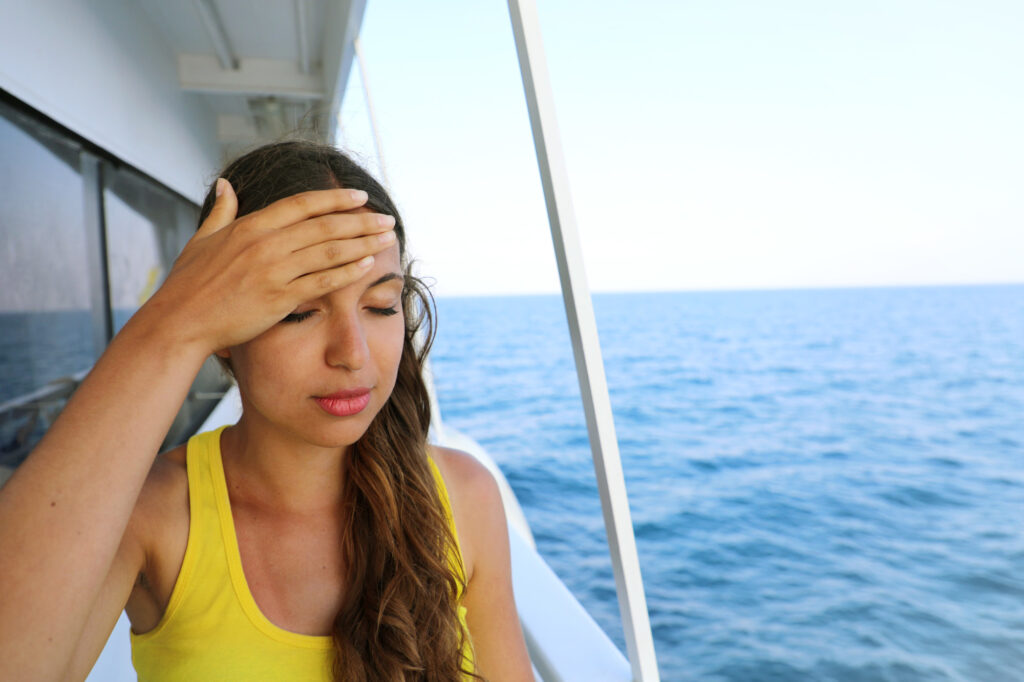
It happens to the best of us: when the high seas get a little too high, we might find ourselves getting sick off the side of the boat instead of enjoying our sunset cruise.
Seasickness is an incredibly common issue, and it can affect anyone. Worse, it may affect you on some chartered trips and not others! The more intense the wind and waves, the more likely you are to experience this condition.
Fortunately, there’s plenty you can do to ensure that your trip on the high seas doesn’t turn into a nightmare. Knowing how not to get seasick can help you plan your trip and lower your risk in advance. Here’s what you should know before you step aboard one of our boats.
Know Why Seasickness Happens
Before we dive into prevention, it can sometimes help to understand why we get seasick.
Seasickness is not a true sickness. Instead, it’s a form of motion sickness, a condition that around 1 in 3 people will be “highly susceptible” to.
Motion sickness happens when the structures in our inner ear, which we use to help with balance, sense unusual shifting or motion underfoot. In addition, the ocean itself gives our eyes fast-moving visual data that can overwhelm our senses.
The result is similar to what you might experience with car sickness. Our brains have trouble processing both the fast-paced visual input outside the car window as well as the unusual speed of our bodies. Worse, our vestibular system reports that we’re standing or sitting still in spite of our bodies’ movement through space.
All of this leads to the feeling of overwhelm that presents itself as motion sickness or seasickness. You might experience seasickness through symptoms like nausea, sweating, light-headedness, headaches, and fatigue.
Many of the tips below can help to address one or more of the factors that cause seasickness, which can help to reduce or even prevent these symptoms.
Get Plenty of Rest
If you want to keep from getting seasick at all, one factor is your sleep. Sleep deprivation can worsen the symptoms of motion sickness, so it’s important to get a full night of rest before you set sail. This is especially true if the next day’s forecast includes rough seas.
Eat Before Your Trip
Given that seasickness is infamous for causing nausea, you might be surprised to learn that you should eat a meal as usual before your cruise.
However, it’s important to pay attention to what you eat before chartering a boat. Avoid foods that tend to cause nausea, such as heavy, spicy, or fatty foods. Don’t overindulge, and avoid alcoholic beverages.
Take Antiemetic Drugs
Antiemetic drugs are over-the-counter medicines that help address or prevent nausea.
If you know you’re prone to seasickness, taking one in advance can sometimes help. These medicines are more effective if they’ve already had time to enter your bloodstream. However, you may also want to have these on hand during your voyage as well.
Though Dramamine and Bonine are the most common antiemetic drugs these days, it’s a good idea to check with your doctor for personal recommendations or prescription alternatives.
Focus Your Gaze
When you’re feeling seasick, it can be tempting to put your head down or look away from the water. Some people also try to focus on their phone screens or read instead. However, these tactics can sometimes lead to confusing sensory data that makes your seasickness worse.
In fact, experts recommend that you look toward a stable object. This constant can help your brain to decipher all of the signals it’s receiving.
If there’s a land mass in sight, that’s a great option to focus on. If not, looking toward the horizon can help. Doing this can also help ensure that you don’t miss the stunning ocean views!
Stay Hydrated
While you’re aboard, make sure to stay hydrated, especially if it’s a hot or sunny day. Dehydration can increase your risk of seasickness, so always have a water bottle ready.
If you want to use a tried-and-true natural remedy for seasickness, consider grabbing a ginger ale as well. This simple beverage can help reduce nausea if you sip it during your trip. The same is true of chamomile, so packing this simple tea can help to soothe an upset stomach.
Try a Seasickness Band
Seasickness bands are wristbands that work via acupressure. They constrict the area around your wrist’s pressure point, which sits atop a nerve that can sometimes trigger nausea. These bands are easy to find in some pharmacies as well as online.
This tactic can be hit-or-miss, as some people swear by them while others claim they don’t offer much help.
Keep Your Anxiety Low
If you’re starting to feel nauseous, anxiety can compound the issue fast. It’s important to stay calm: your voyage won’t last forever, and most people find that they can overcome seasickness with the tips on this list.
Make sure to avoid shallow, anxious breathing, as keeping your breathing steady can help you prevent the light-headedness associated with motion sickness.
Don’t Hold It In
If the worst should happen and you do start feeling the urge to get sick, don’t hold it in. Most of the time, giving in to the urge will make you feel better afterward. Again, seasickness affects a huge number of people, so there’s absolutely nothing to be ashamed of.
Know How Not to Get Seasick
Though no one will ever be immune to this condition, knowing how to not get seasick can help you lower your risk. With a bit of advance planning, you can prepare for your cruise and get your sea legs under you fast.
Ready to take the plunge? With plenty of fishing trips and tours to choose from, we offer comfort and style on every voyage. Contact us today to book your next trip.
